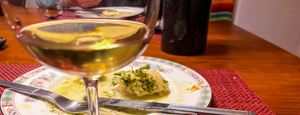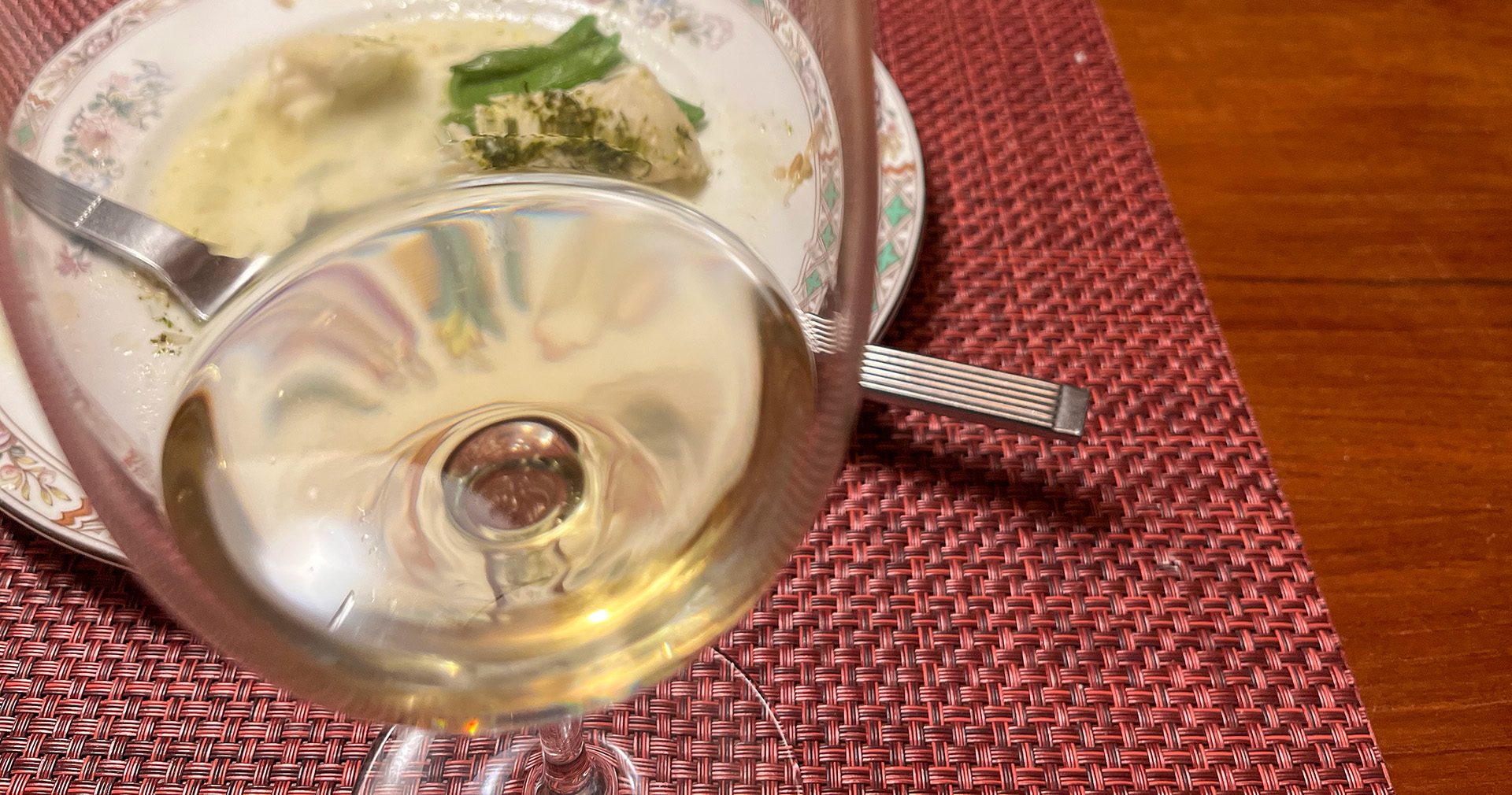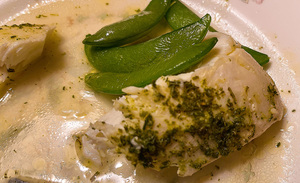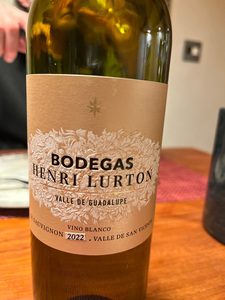January 11, 2025
Fresh, but frozen halibut (in season in the winter) was abut $20/pound from Whole Foods. We poached a 1.5 inch thick, one pound piece in an oval LeCreuset, served it with steamed snow peas and a white Rams Gate Chardonnay, that was marked $35. I made no other notes on the bottle and can’t remember where we purchased it. Pre-move to Santa Fe, so we suspected we bought it at a wine tasting at Pearl Street Wine in Denver.
1.5 inch thick, one pound piece in an oval LeCreuset, served it with steamed snow peas and a white Rams Gate Chardonnay, that was marked $35. I made no other notes on the bottle and can’t remember where we purchased it. Pre-move to Santa Fe, so we suspected we bought it at a wine tasting at Pearl Street Wine in Denver.
The Poached Fish
Pre-heat oven to 375 degrees F. The fish is placed skin side down on a slight film of olive oil in a LeCreuset that allows it to fill most of the bottom. A few exterior (but white) onion pieces where placed around the filet, slightly raising the one thinner section. Slices of one-half lemon go on top and 1/2 cup of dry white wine should be poured over all.
The casserole was placed in the oven when at temperature; timer set for 30 minutes. I crushed some dried rosemary from the summer’s garden, adding a little salt and a few exotic peppercorns to the mortar. When the timer rang, I turned off the oven and turned on the broiler (full, high) and removed the fish to a platter, separating it from the skin. I brushed the top with butter and rubbed the rosemary mixture on top. The platter was placed in the broiler for about 5 minutes. I strained the juices from the casserole, and warmed them, thickening the sauce with a small amount of cashew crumbs (ground in the same mortar).
Results were delicious, but the fish could have baked/poached for about 5 minutes less.
The wine

I served this chardonnay with the fish and they complemented each other well. It is a golden white with smell of apricot and butter. Like most California Chardonnays it tastes of malolactic fermentation but not overly so. Not too acidic, so the lemony sauce was the tartest taste at the table. Sweet snow peas are a nice third wheel so the meal hit every flavor group – halibut being an umami fish.
The cooking began with a glass of the wine of the month from Susan’s – a Mexican white. On it’s own it was a weird taste, complex but unrecognizable. With food, when the Chardonnay was empty, the wine tasted much better. I’d buy it again if under $20. Apparently, it sells for around $25 and is Chenin Blanc, a grape originally from the Loire region of France. It is sweet but with high acidity.
This is how the winemakers describes his wine: Made with grapes from centenary vines from the Santo Tomas vineyard in Valle de Guadalupe; Pressed on a Bucher Inertys pneumatic grape press under controlled atmosphere to guarantee our pressed juices are extracted without oxidation of aromas and color and integrally fermented in new 500L French oak barrels so as to have a more subtle aroma with refined and elegant wood hints. Our Chenin Centenario 2015 is aged on lees for 10 months.
From wikipedia: the less-ripened grapes are made into popular sparkling wines such as Crémant de Loire. The white wines of the Anjou AOC are a popular expression of Chenin as a dry wine, with flavors of quince and apples. In nearby Vouvray AOC, vintners aim for an off-dry style, developing honey and floral characteristics with age.
In 1999, DNA analysis showed that Chenin blanc has a parent-offspring relationship with the Jura wine grape Savagnin. Additional DNA evidence shows that Chenin blanc shares a sibling relationship with Trousseau and Sauvignon blanc (both grapes the likely offspring of Savagnin), which strongly suggests that Chenin blanc is the offspring and Savagnin is the parent variety. Through Chenin’s half-sibling relationship with Sauvignon blanc, the grape is related as an aunt/uncle variety to the Bordeaux wine grape Cabernet Sauvignon which is the offspring of Sauvignon blanc and Cabernet Franc.[6]


